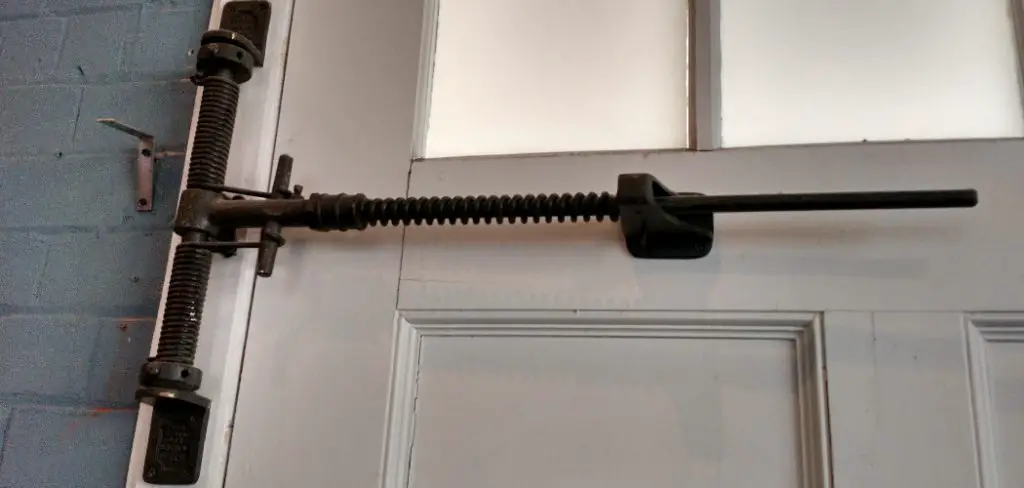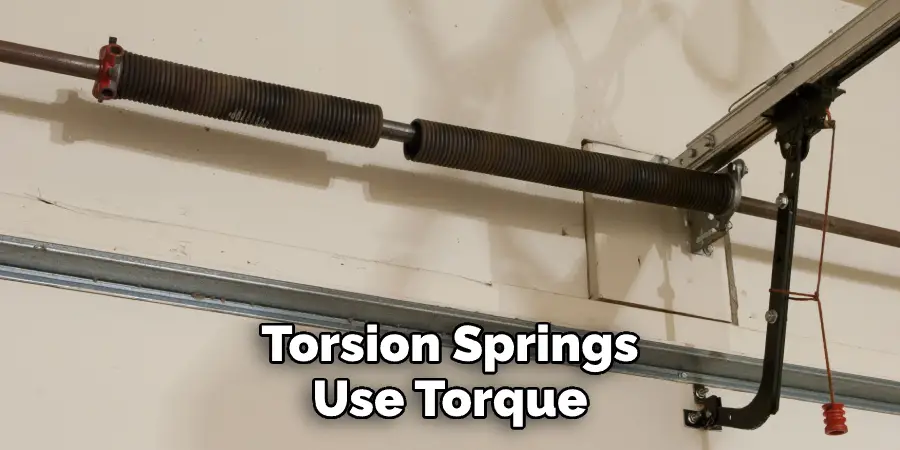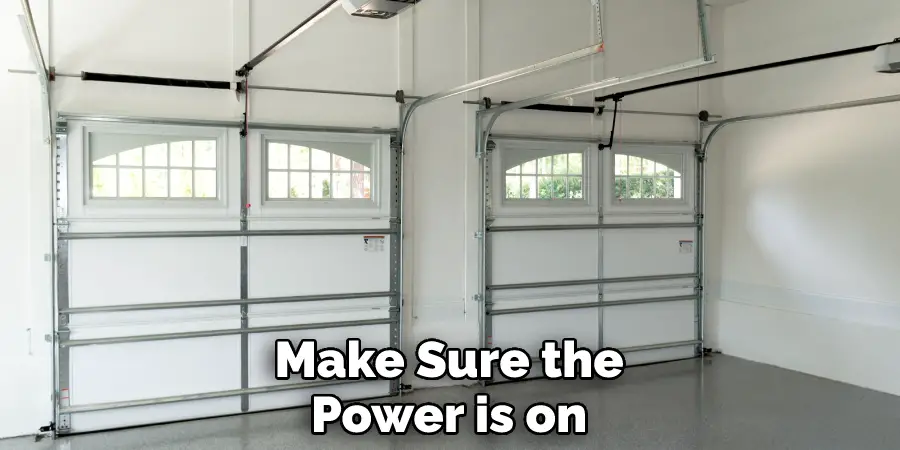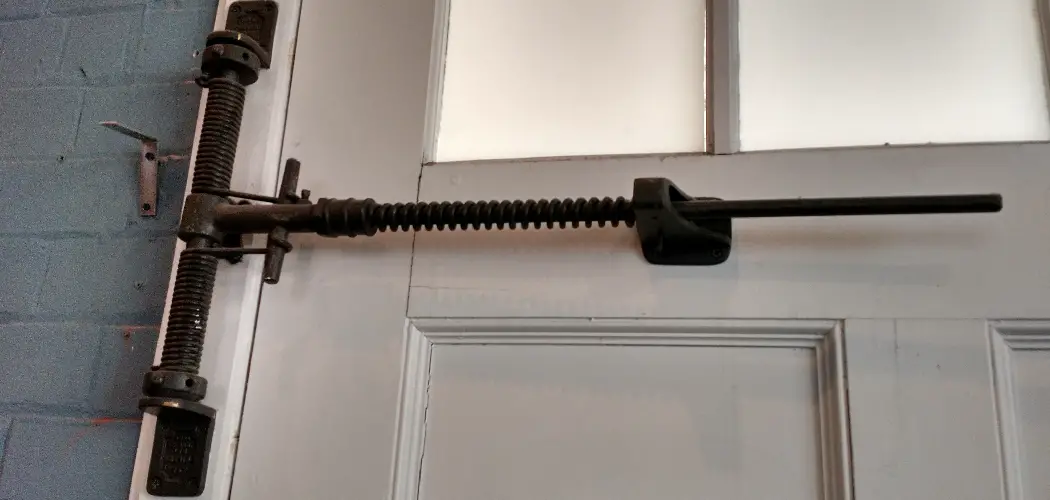As a homeowner, you must know if your garage door spring is broken. This way, you can address the issue before it becomes a bigger problem. This blog post will discuss the signs of a broken garage door spring and what you can do about it. Keep reading for more information about how to tell if garage door spring is broken.

Summary: The garage door spring is an essential component that helps lift the door smoothly. As it is subjected to a lot of stress, it can eventually break, leading to potential safety hazards. There are several signs that indicate a broken garage door spring, including the door not opening or closing smoothly, unusual noises or vibrations, gaps in the spring, or visible signs of wear and tear.
What Is a Garage Door Spring?
If you have a garage door, chances are it has a spring (or two) that helps to counterbalance the heavy door. Garage door springs come in two different types: torsion springs and extension springs. Torsion springs are above the door, while extension springs are on each side. Both types of springs work to help raise and lower the door, but they do so in different ways.
Torsion springs use torque to lift the door, while extension springs simply stretch and contract as the door moves. Garage door springs are under a lot of tension, so it’s important to make sure they are in good working condition. If one breaks, it can cause serious injury. If you’re not sure how to check or replace your garage door spring, it’s best to call a professional.

Why Might You Need to Tell if Garage Door Spring Is Broken?
Garage door springs are one of the most important parts of your garage door and can also be one of the most dangerous. That’s why it’s important to know how to tell if garage door spring is broken. If you suspect that your garage door spring is broken, the first thing you should do is call a professional.
Attempting to fix a broken garage door spring yourself can be extremely dangerous, and it’s not something that you should attempt unless you have the proper training and experience. However, a professional can quickly and safely repair or replace your broken spring, ensuring that your garage door is back in working order.
12 Steps to Follow How to Tell if Garage Door Spring Is Broken
Step 1: Visually Inspect the Garage Door Springs:
Begin by visually inspecting the garage door springs for signs of damage or wear. Garage door springs are typically located either directly above the door (torsion springs) or on each side of the door (extension springs). Look for any visible signs of a broken spring, such as a gap in the spring, uneven coils, or a spring that is visibly out of place.
Step 2: Check for Loose or Hanging Cables:
If the garage door spring is broken, the cables that run alongside the door may become loose or dislodged from their proper position. Inspect the cables for any signs of slackness or hanging, as this may indicate a broken spring.
Step 3: Test the Balance of the Garage Door:
To test the balance of your garage door, first, disengage the automatic garage door opener, if you have one, by pulling the emergency release cord. This cord is typically red and hangs from the opener’s motor unit. Once disengaged, manually lift the garage door halfway up and then let go. If the door remains in place or moves only slightly, the springs are likely in good working condition. If the door slams shut or feels very heavy, this may indicate a broken spring.
Step 4: Listen for Unusual Sounds:
When operating the garage door, listen for any unusual sounds, such as loud bangs, squeaks, or grinding noises. A broken spring may cause the door to make a loud noise when it breaks or when the door is in motion. Unusual sounds may also indicate that the spring is damaged or about to fail.
Step 5: Observe the Garage Door’s Motion:
Pay close attention to the garage door’s motion when opening or closing. A broken spring can cause the door to open or close unevenly, with one side appearing higher or lower than the other. Additionally, the door may struggle to open or close, or the opener may seem to strain under the weight of the door. These signs may indicate a broken spring.
Step 6: Test the Garage Door Opener’s Force Setting:
If you have an automatic garage door opener, test the force setting to determine if the issue is related to the springs or the opener itself. To do this, disengage the opener by pulling the emergency release cord, then attempt to manually lift the door. If the door feels extremely heavy or difficult to lift, the issue is likely related to the springs. If the door opens and closes smoothly by hand, the problem may be with the opener’s force setting or another component.
Step 7: Inspect the Garage Door’s General Condition:
While examining the garage door springs, take the opportunity to inspect the overall condition of the door and its components. Look for signs of wear, rust, or damage on the tracks, rollers, hinges, and other hardware. Addressing any issues with these components can help prevent further damage to the garage door system and prolong the life of the springs.
Step 8: Consult a Garage Door Professional:
If you suspect that your garage door spring is broken or damaged, consult a garage door professional for further assessment and repair. Garage door springs are under extreme tension and can be dangerous if not handled properly. A professional will have the necessary tools, knowledge, and experience to safely diagnose and repair the issue.
By following these steps, you can effectively determine if your garage door spring is broken or damaged. Regularly inspecting and maintaining your garage door system can help prevent spring failure and ensure the safe and efficient operation of your garage door. If you suspect a broken spring, always consult a garage door professional for expert assistance and repair.
Step 9: Perform Regular Maintenance:
Regular maintenance of your garage door system can help prevent spring failure and prolong the life of your springs. Lubricate the springs, rollers, and hinges with a garage door-specific lubricant every six months to reduce friction and wear. Additionally, keep the garage door tracks clean and free of debris to ensure smooth operation.
Step 10: Monitor the Lifespan of Your Garage Door Springs:
Garage door springs have a limited lifespan, typically rated in cycles (one cycle is one complete opening and closing of the door). Torsion springs generally last between 15,000 to 20,000 cycles, while extension springs last between 10,000 to 15,000 cycles. Keep track of the age and usage of your springs to anticipate when they may need replacement.
Step 11: Consider Upgrading Your Garage Door Springs:
If you find yourself frequently dealing with broken springs, consider upgrading to a higher-quality spring. Higher-cycle springs are more durable and have a longer lifespan, which can save you time and money in the long run. Consult a garage door professional to discuss your options and choose the right spring for your needs.
Step 12: Educate Yourself on Garage Door Safety:
Understanding the potential dangers associated with garage doors and their components can help you identify issues and take appropriate safety precautions. Familiarize yourself with the safety features of your garage door system, such as the emergency release cord, and educate your family members on their proper use. Always exercise caution when working around garage doors, and never attempt to repair or replace a broken spring on your own.
By following these comprehensive steps and guidelines, you can effectively diagnose a broken garage door spring and take the necessary steps to ensure the safe and efficient operation of your garage door. Regular inspection, maintenance, and professional assistance will help prolong the life of your garage door system and provide peace of mind for you and your family.
What to Do if Your Garage Door Spring Breaks
If your garage door spring breaks, don’t panic! You can still open your door manually. Start by disconnecting the door from the opener, then lift the door until the broken spring is fully extended. Once the spring is extended, release the door so that it can fall freely. This will help to unwind the spring.
Next, use a pair of pliers to remove the spring from the brackets that hold it in place. Once the spring is removed, you can order a replacement from a garage door supplier. To install the new spring, simply reverse the steps you took to remove the old one. You can easily fix a broken garage door spring with a little patience and some basic handyman skills.

10 Signs You Need a New Garage Door Spring
- Your door is very heavy and difficult to open. This is a sign that your springs are no longer counterbalancing the weight of your door and need to be replaced.
- You notice that your door isn’t opening and closing as smoothly as it used to. Worn-out springs can cause your door to shake and rattle when in use, indicating that they need to be replaced.
- You notice gaps in your door that don’t seal properly. This could be due to your springs no longer providing the proper tension, causing your door to sag.
- Your door opens or closes on its own. This is a serious safety hazard and indicates that your springs are not functioning correctly.
- Your garage door opener starts making strange noises. If you hear grinding, popping, or other strange noises from your garage door opener, it could indicate that your springs need to be replaced.
- You see rust on your springs. Rust is a sign of wear and tear and should be addressed immediately to prevent further damage.
- Your springs are more than seven years old. Springs typically need to be replaced every 7-10 years, so if yours are getting up there in age, it’s probably time for new ones.
- You have recently had a garage door repair or replacement. If you’ve recently had any work done on your garage door, it’s possible that new springs were not installed correctly or are of a different size than what was originally there. This can cause problems down the line and should be checked by a professional.
- You notice cracks in your spring coils. Small cracks are normal and can happen over time, but if you notice large cracks or twisted coils, this is a sign that your springs need to be replaced immediately.
- Your garage door won’t open at all . If your garage door refuses to open, it’s likely that one or both of your springs have broken and will need to be replaced before your door will function properly again.
The Cost of Replacing a Garage Door Spring
Replacing a broken garage door spring can be a daunting task, and the cost of hiring a professional to do it can be prohibitive. However, with a little know-how and the right tools, it’s a relatively simple job that most homeowners can handle independently. The average cost of replacement springs ranges from $100 to $200, depending on the size and type of door.
For most people, the biggest expense will be the cost of renting or purchasing the special tools required for the job. However, once you have the necessary tools, replacing a garage door spring is a fairly straightforward process that should take less than an hour to complete. As such, it’s a great way to save money on potential repairs without sacrificing quality or safety.
The Consequences of A Broken Garage Door Spring
A broken garage door spring can have serious consequences for your garage and home. The spring is what helps to counterbalance the heavy door, making it easier to open and close. Without a spring, the door will be much harder to move and may even become stuck in a closed position. In addition, a broken spring can put undue stress on the opener, potentially leading to a failure.
If the opener is not working properly, you will be unable to open or close the door, trapping your car inside or leaving your home vulnerable to break-ins. As such, it is important to have a broken spring repaired as soon as possible.
Trouble Shooting Tips for When Your Garage Door Isn’t Working
If your garage door isn’t working, don’t panic! You can try a few simple troubleshooting tips before calling a professional. First, check to make sure the power is on. If the garage door opener is plugged into an outlet, make sure the circuit breaker hasn’t tripped. Next, take a look at the tracks and see if there is any build-up of debris or dirt that could be preventing the door from moving smoothly.
If the tracks look clear, check the springs to see if they are broken or need to be adjusted. Finally, examine the rollers to see if they are worn out or damaged. If you can’t identify the problem, or if your attempts to fix it aren’t successful, then it’s time to call a professional garage door repair service. With their help, your garage door will work like new in no time!

Conclusion
If you’re not sure whether your garage door spring is broken, there are a few things you can do to check. One of the easiest ways to tell is if your garage door opener struggles or takes a long time to open and close the door.
You can also try lifting the door yourself; if it feels especially heavy, that’s another sign that the spring might be broken. If you have any doubts, it’s always best to call in a professional for help. Thanks for reading our post about how to tell if garage door spring is broken.
I am Rick. I grew up helping my dad with his handyman service. I learned a lot from him about how to fix things, and also about how to work hard and take care of business. These days, I’m still into fixing things- only now, I’m doing it for a living.
I’m always looking for new ways to help people grow and develop. That’s why I have created this blog to share all my experience and knowledge so
that I can help people who are interested in DIY repair.

